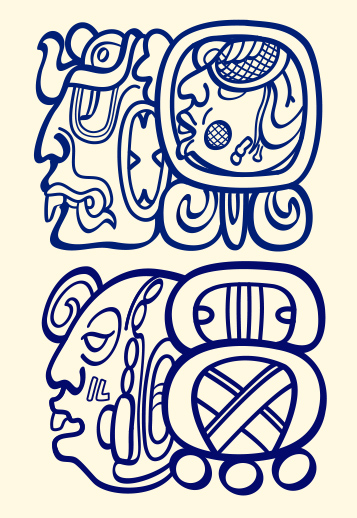
4 Ajaw 8 Sip. Drawing by Jorge Pérez de Lara
To Know Where We Are From: The Writing of the Ancestors reaches Zinacantán
Today, as the days are growing longer, we celebrate the special day 4 Ajaw, which commemorates the anniversary of the beginning of the Long Count Era on 4 Ajaw 8 Kumk’u in 3114 BC—and again on 4 Ajaw 3 K’ank’in in 2012. May the world be made anew once again. This month, we hear from Ana Guadalupe de la Torre, a first-time recipient of a MAM mini-grant from Zinacantán, Chiapas, Mexico. Ana originally proposed to work with fifteen young Tzotzil Maya from Zinacantán, but interest in the workshop was so great that the numbers quickly swelled to forty students! We are very inspired and encouraged by the work Ana and her colleague Susana Patricia López Díaz are doing in teaching their curriculum in Tzotzil, and we are so happy to support her and her community learn the script of their ancestors for the first time. Thank you to all of our supporters for making this work possible.
Bats’i kolavalik,
Michael Grofe, President
MAM
Introductory Workshop to the Reading and Writing of Maya Hieroglyphs in Zinacantán, Chiapas

Students deciphering the text on Stela 12 from Yaxchilán.
Zinacantán is located in the Highlands of Chiapas, and it is a town inhabited by women and men who speak the Tzotzil language. This place is called Sots’leb, which means ‘Place of Bats’. Here we still conserve ancestral traditions, respect for the sacred hills, the planting of the sacred corn, the main food for all of us, ceremonies in gratitude for water, carrying and elaborating traditional costumes on the back-strap loom. All of this cultural richness, and the knowledge that we have inherited from our Maya grandfathers and grandmothers—in every generation it is lost, weakening, losing the essence and meaning of each bit of knowledge. In this town most people speak Tzotzil, although now only the elderly speak Tzotzil with the essence and meaning of each word they communicate. Young people today speak a mixture of Tzotzil with Spanish, because of the influence of the mass media, the educational system that is completely in Spanish, and that there are no materials or subjects in the Tzotzil language. Also, because there are parents who no longer communicate with their children in Tzotzil, a higher percentage of the entire population can not write In the Tzotzil language, so the interest in speaking and writing in our language is increasingly lost.

4 Ajaw 8 Sip. Dibujo por Jorge Pérez de Lara
Para Saber de Dónde Somos: La escritura de los antepasados llega a Zinacantán
Hoy, a medida que los días se alargan, celebramos el día especial 4 Ajaw, que conmemora el aniversario del comienzo de la era de la cuenta larga en 4 Ajaw 8 Kumk’u en 3114 aC, y nuevamente en 4 Ajaw 3 K’ank’in en 2012. Que el mundo vuelva a ser renovado. Este mes, leemos a Ana Guadalupe de la Torre de Zinacantán, Chiapas, México, quien recibió por primera vez una mini-beca MAM. Ana originalmente propuso trabajar con quince jóvenes tzotziles mayas de Zinacantán, ¡pero el interés en el taller fue tan grande que los números aumentaron rápidamente a cuarenta estudiantes! Estamos muy inspirados y animados por el trabajo que Ana y su colega Susana Patricia López Díaz realizan cuando enseñan su programa de estudios en tsotsil, y estamos muy felices de poder ayudar tanto a ella como a su comunidad a aprender la escritura de sus antepasados por primera vez. Gracias a todos los que nos apoyan a hacer posible este trabajo.
Bats’i kolavalik,
Michael Grofe, Presidente
MAM
Taller de Introducción a la Lectura y Escritura de los Jeroglíficos Mayas en Zinacantán, Chiapas

Descifrando el texto de la estela 12 de Yaxchilán.
Zinacantán se encuentra en la Región de los Altos de Chiapas. Es un pueblo donde habitan mujeres y hombres hablantes de la lengua tsotsil. Éste lugar se llama Sots’leb, que significa “lugar de murciélagos”. Aquí aún se conservan tradiciones ancestrales, el respeto a los sagrados cerros, la siembra del sagrado maíz, el principal alimento de todos y todas y ceremonias en agradecimiento al agua. Sus habitantes portan y elaboran los trajes tradicionales en telar de cintura. Toda esa riqueza cultural, y conocimientos que nuestros abuelos y abuelas mayas nos han heredado, se va perdiendo y debilitando cada generación, por la pérdida de la esencia y el significado de cada conocimiento. En éste pueblo la mayoría de la gente habla tsotsil, aunque ahora sólo la gente mayor habla en tsotsil con la esencia y el significado de cada palabra que comunican. Los jóvenes en la actualidad hablan una mezcla de tsotsil con español, por la influencia de los medios masivos, porque el sistema educativo es completamente en español y no hay materias o asignaturas en lengua tsotsil y también porque hay padres que ya no se comunican con sus hijos en tsotsil, una mayoría de la población no sabe escribir en la lengua tsotsil y cada vez se va perdiendo el interés de hablar y escribir en nuestra lengua. Continue reading

